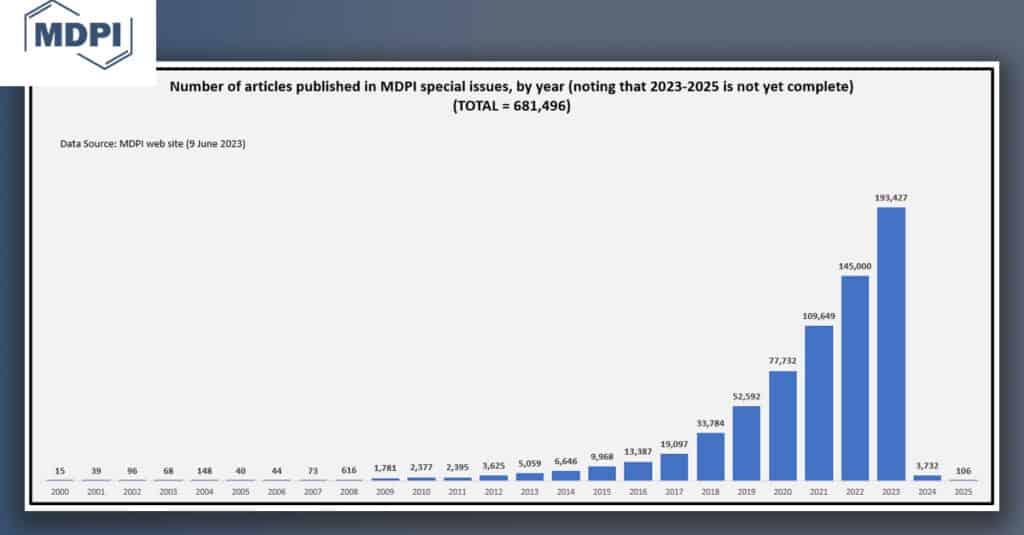On our Twitter account, we have been looking at MDPI. Not from the point of view of them being a predatory publisher. Indeed, we were keen to say that this was not the purpose of our tweets, it was more to provide some facts and figures that we may be able to arrive at a conclusion, or provide others with the information to arrive at their own conclusion.
Special issues
When we started tweeting about MDPI, one of the things that became apparent was the number of special issues that they published.
As an example, the Journal of Molecular Sciences has 4,216 special issues in 2023. That is, 11.50 special issues closing every day (or 13.47 if we exclude weekend). We made this point in this tweet.
In another tweet, we asked if an Editor-in-Chief has the capacity to oversee 3,328 special issues in a given year? This question was asked on the basis of the recent COPE (Committee on Publications Ethics) discussion document that is proposing that the Editor-in-Chief has ultimate responsibility for all special issues published by the journal.
We also tweeted about an article written by MA Oviedo-Garcia, which looked at 14 issues that had been found with MDPI special issues.
Previous analysis
The first analysis we did on MDPI special issues, was done by accessing the sections web page of a given journal, which provided details of all the sections in the journal and how many special issues each section has. For example, see the sections for MDPI’s journal Animals (archived here).
The problem with this analysis was that it was difficult to collect data for every journal and there might be (might not, we did not check this) special issues that are not part of a section, so it would be missed.
Latest analysis
As we wanted to do a complete analysis, we looked again at how we collected the special issues data.
In fact, each journal has a special issues page (see for example MDPI’s journal Animals – archived here), which enables us to more easily collect the special issue data from each of MDPI’s 427 journals.
The headline statistics
After collecting all the data, we can report that in 2023, MDPI have 65,191 special issues. That is 178.61 special issues with a closing date every day. You can see the tweet that we made about this by following the link.
The image that we presented in the tweet (Figure 1) shows the number of special issues closing each year, by year (as at 9 June 2023).
Special issues represent 681,495 articles, with 145,000 of those in 2022 and 193,427 in 2023 (and counting). We tweeted about this here. The graph we used can be seen in Figure 2.
It should be noted that this is the number of articles that were published when the closing date of the special issue was in that year and not, necessarily the year the article was published.
To further demonstrate this, 2024 already has 3,732 articles which would be published in 2023, for special issues that close in 2024. Even 2025 has 106 articles recorded.
The top ten
Below, we present 11 graphs. The first graph shows the top ten MDPI journals (ranked by the number of special issues in 2023). The next ten graphs show each of those journals, but showing how many special issues closed each year.
Without exception, the number of special issues closing in 2023 is significantly higher than previous years. This could be because MDPI are making an effort to publish more special issues. Or it might be that they advertise a lot, and many do not attract any papers so they drop off the radar at the end of the year.
Now that we have the data, we can carry out another data collection exercise sometime in 2024 and compare against the data we have just collected. That may provide more insights.
If you click on one of the graphs above, you should be able to see it more clearly and also navigate through each one.
Final comments
In the opening remarks, we said that we are not accusing MDPI of being a predatory publisher. The aim of our current data collection exercise is just that, to collect data. If nothing else, it gives us a data, which comprises over 680,000 individual data points.
Our current thoughts are to carry out a similar data collection exercise in 2024, just to see if the rise of special issues in 2023 does pan out (or if many wither on the vine as they do not get any submissions).
We will also follow the COPE document with interest that suggests that an Editor-in-Chief should have oversight of all the special issues that are produced by a given journal. As we asked in a tweet, can an EiC really have oversight of 3,328 special issues?
MDPI may argue that each section in a journal has its own Editor-in-Chief. For example, see the Editorial Board page for the Journal of Molecular Sciences [archived here] (this is the journal that was the subject of the tweet we mentioned), and you can see that each section has a “Section Editor-in-Chief“. This raises two questions (at least to us):
- Given the large number of sections MDPI journals can have, is it right that each one has its own EiC? If so, what is the relationship between the section EiC’s and the journal EiC and who carries the overall responsibility?
- We questioned whether an EiC could oversee over 3,000 active special issues and that this may be the reason for section EiCs. Looking at the sections for the Journal of Molecular Sciences (archived here), some sections have a significant number of special issues. For example, the section “Molecular Pathology, Diagnostics, and Therapeutics” has 583 active special issues and the section “Molecular Biology” has 303 active special issues. We would raise the same question as before, can an Editor-in-Chief have oversight of this number of special issues?
So, our plan it to keep a watching brief on MDPI special issues, collect some more data at an appropriate time and we are considering writing our findings up into a paper that we will send out for peer review but that will depend on what any new data reveals.




